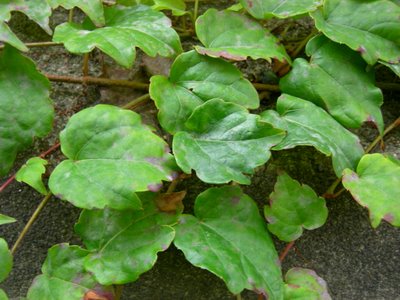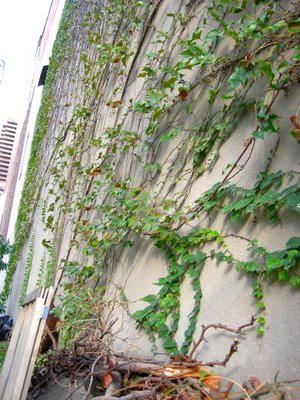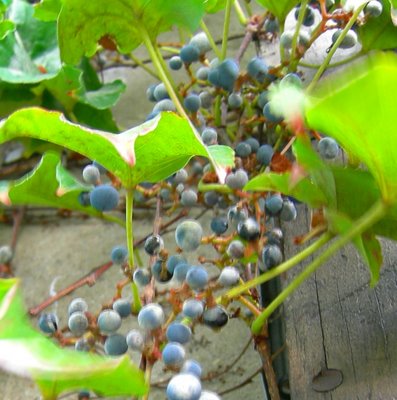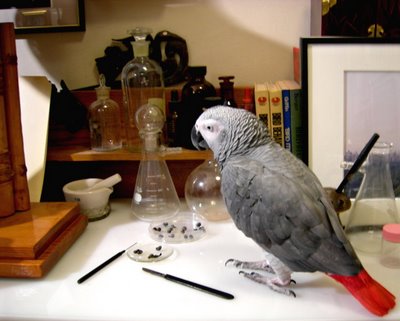
Photo: Donegal Browne
The birdie "Shroud of Turin" or Dot smacks into the window

Photo:Donegal Browne
Dot, who finally stopped whacking me with his wing and attempted to menace me with a look long enough to have his photo taken.
The mystery plant identifier's name is out, as he dropped me a line. A big bravo for Mark Upton for Boston Ivy. Who also had a question about Dot, the bird who collided with my kitchen window.
Mark wrote:
I've been wondering what species of bird Dot is. If she is a big owl, which she seemed to be from the birdie "Shroud of Turin", it's probably difficult to keep her with all the other critters. How do you handle that?
Mark,
The imprint does look quite owlish, I agree. Something to do with size and Dot's trajectory. As to Dot, it's not an illusion, he is actually bigger than a lot of owls but in reality he's a bumper sized Rock Dove. (Yes, yes, I know they've changed it to Rock Pigeon, but I'm holding out. Considering all the revilement pigeons get, I somehow feel that a common name that includes "dove" might help their rep.:-)
As to how we handle him with all the other critters, he is only let out of his cage when everyone else is in theirs. Originally all the males came out of their cages at the same time. Blue, another Rock Dove, who can fly but as he'd fallen from the nest and broken his shoulder as a squeaker, he's not perfect. The wing healed but with a bit of a crook that might make competing with all the tough NYC street birds a bit of a problem. Then there is Pinkie. He is a Laughing Dove, or White Ringneck who we rescued from a snow bank in the Bird Park. He seemed to have just walked himself in and huddled in the snow waiting for aid as his wings were clipped.
BAck in the days when we had group male flight, Blue would fly about a bit then stand on his cage territorially and circle and coo, like any well socialized guy. But Dot when released would make a beeline for Blue's cage and either try to get in it at which time Blue would just have to go in after him or Dot would just skip that part and muscle into Blue and grab him by the neck. No one ever got damaged but the feathers would fly with Blue giving as good as he got. So that settled that, no communal flight time for those two.
Then there is tiny Pinkie, slim, all white with little pink eyes, who is at most a fifth of Dot's weight, still with clipped wings at the time, and pushing his luck in a major way.
I don't know if you're familiar with Laughing Doves but they are a domesticated species, who display by puffing up, spreading their tails, making an irregular cooing noise, then several, hop, hop, hops forward. At which time they begin the "laugh", Tee heee heeee heeee heee, auk, Tee heeeheeeheee, auk, making little bows, head level with feet, tail in the air, the entire time. This is so weird to the other birds that if Pinkie shows up in their proximity, they just look at him, "Whoa, that is really strange.", and fly off.
Pinkie quite enjoys this sense of power. He can keep EVERYONE, and everyone is bigger than he is, out of the bath bowl if he wants to. Quite satisfying. Then he goes over and perches on the edge of the cat's water bowl, I think, in hopes they'll show up for a drink, and he can do his number on them.
Needless to say, I haven't tested my theory. He's far too small and flitty for the cats to resist.
At any rate, one evening Pinkie decided to keep Dot out of the bath. And instead of doing a studied retreat this time, Dot stood and watched him get closer, hop, hop, hop, teeeheeeheeehee, closer, bow, bow, bow...And on the third bow, Pinkie's neck was so inviting Dot went for it. Sorry, boys, no more free time together for you guy's either.
And where was Quicksilver the top bird of the house during all this? Well, usually in the bedroom watching television with the cats. But at times before the episode I'm about to recount, if he were having a snack in the dining room, he has a perch on a high chair that makes him the right height to eat off a plate at the table. Just like the rest of the "flock" that speaks English. He'd stay munching away while the other birds had flight time. That is until the evening Dot came out of his cage like a bolt of lighting. He smacked his chest into Silver's, who was casually just finishing up a scrambled egg, napkin in foot about to wipe his beak, and BAM! Dot knocked Silver for a loop, right off his perch and onto the floor.
Now this may happen once but there is no way Silver is going to let it happen twice. He was now forewarned and like all good parrots, he holds a grudge. Besides he's quick. I once saw him snip a wasp in half that made the mistake of zipping a flight path too near Silver's head. And in a Quicksilver/Dot interaction, Dot really could easily be hurt. So these days, Silver always keeps the cats, Tom, Chekhov, and Bowie, company watching PBS during cage cleaning. Cartoon Network makes them all far too energized for that time of day.
That doesn't even include the antics of the girls, Tip, Edge, Thumper, Star, and Sesame, plus the various birds sporadically being rehabbed in the bathrooms.
And people wonder why my blog tends to go up at 2 or 3 in the morning. :-)
Thanks again,
Donegal









